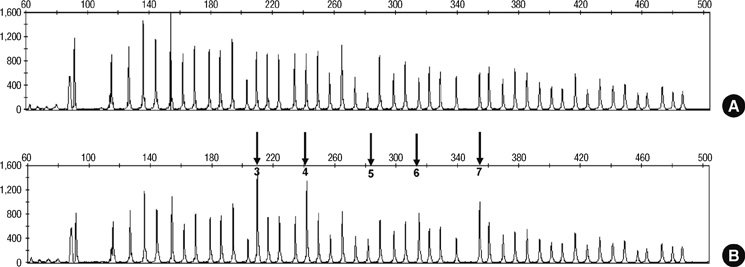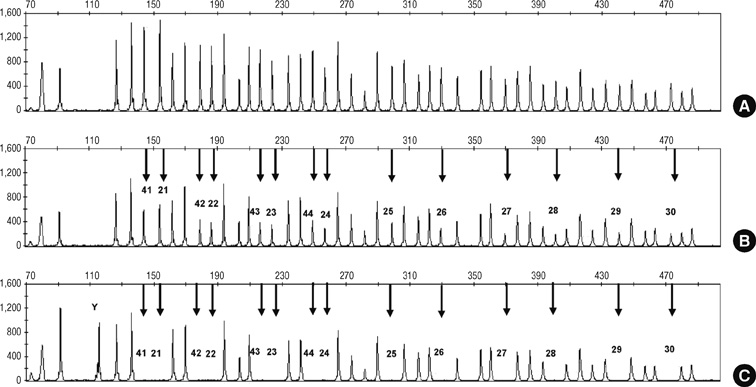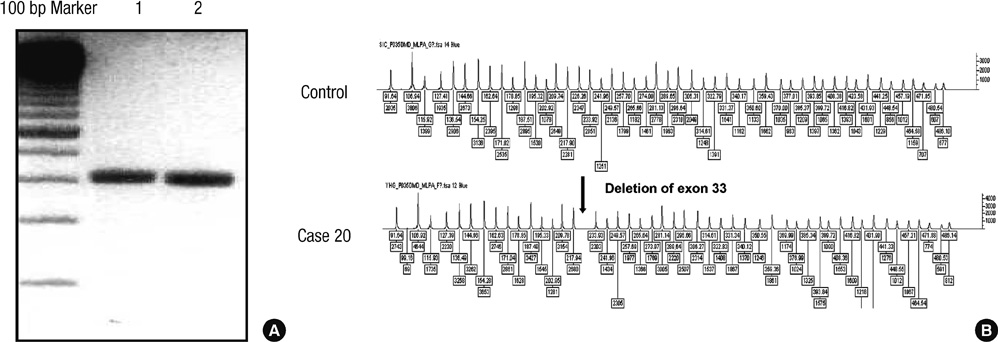J Korean Med Sci.
2012 Mar;27(3):274-280. 10.3346/jkms.2012.27.3.274.
Genetic Analysis of Dystrophin Gene for Affected Male and Female Carriers with Duchenne/Becker Muscular Dystrophy in Korea
- Affiliations
-
- 1Department of Pediatrics, Pusan Paik Hospital, Inje University College of Medicine, Busan, Korea.
- 2Department of Pediatrics, Eulji General Hospital, Seoul, Korea.
- 3Department of Pediatrics, Samsung Changwon Hospital, Sungkyunkwan University School of Medicine, Changwon, Korea.
- 4Department of Laboratory Medicine and Genetics, Samsung Medical Center, Sungkyunkwan University School of Medicine, Seoul, Korea.
- 5Department of Pediatrics, Samsung Medical Center, Sungkyunkwan University School of Medicine, Seoul, Korea. jhnr.lee@samsung.com
- KMID: 1792998
- DOI: http://doi.org/10.3346/jkms.2012.27.3.274
Abstract
- Duchenne and Becker muscular dystrophy (DMD/BMD) are X-linked recessive disorders caused by mutation in dystrophin gene. We analyzed the results of a genetic test in 29 DMD/BMD patients, their six female relatives, and two myopathic female patients in Korea. As the methods developed, we applied different procedures for dystrophin gene analysis; initially, multiplex polymerase chain reaction was used, followed by multiplex ligation-dependent probe amplification (MLPA). Additionally, we used direct DNA sequencing for some patients who had negative results using the above methods. The overall mutation detection rate was 72.4% (21/29) in DMD/BMD patients, identifying deletions in 58.6% (17/29). Most of the deletions were confined to the central hot spot region between exons 44 and 55 (52.9%, 7/19). The percentage of deletions and duplications revealed by MLPA was 45.5% (5/11) and 27.2% (3/11), respectively. Using the MLPA method, we detected mutations confirming their carrier status in all female relatives and symptomatic female patients. In one patient in whom MLPA revealed a single exon deletion of the dystrophin gene, subsequent DNA sequencing analysis identified a novel nonsense mutation (c.4558G > T; Gln1520X). The MLPA assay is a useful quantitative method for detecting mutation in asymptomatic or symptomatic carriers as well as DMD/BMD patients.
MeSH Terms
Figure
Cited by 2 articles
-
Multiplex Ligation-Dependent Probe Amplification in X-linked Recessive Muscular Dystrophy in Korean Subjects
Mi Ri Suh, Kyung-A Lee, Eun Young Kim, Jiho Jung, Won Ah Choi, Seong-Woong Kang
Yonsei Med J. 2017;58(3):613-618. doi: 10.3349/ymj.2017.58.3.613.Duchenne Muscular Dystrophy and Becker Muscular Dystrophy Confirmed by Multiplex Ligation-Dependent Probe Amplification: Genotype-Phenotype Correlation in a Large Cohort
Seena Vengalil, Veeramani Preethish-Kumar, Kiran Polavarapu, Manjunath Mahadevappa, Deepha Sekar, Meera Purushottam, Priya Treesa Thomas, Saraswathi Nashi, Atchayaram Nalini
J Clin Neurol. 2017;13(1):91-97. doi: 10.3988/jcn.2017.13.1.91.
Reference
-
1. Muntoni F, Torelli S, Ferlini A. Dystrophin and mutations: one gene, several proteins, multiple phenotypes. Lancet Neurol. 2003. 2:731–740.2. Emery AE. Population frequencies of inherited neuromuscular diseases: a world survey. Neuromuscul Disord. 1991. 1:19–29.3. Prior TW, Bridgeman SJ. Experience and strategy for the molecular testing of Duchenne muscular dystrophy. J Mol Diagn. 2005. 7:317–326.4. Hu XY, Ray PN, Murphy EG, Thompson MW, Worton RG. Duplicational mutation at the Duchenne muscular dystrophy locus: its frequency, distribution, origin, and phenotypegenotype correlation. Am J Hum Genet. 1990. 46:682–695.5. Roberts RG, Bobrow M, Bentley DR. Point mutations in the dystrophin gene. Proc Natl Acad Sci U S A. 1992. 89:2331–2335.6. Traverso M, Malnati M, Minetti C, Regis S, Tedeschi S, Pedemonte M, Bruno C, Biassoni R, Zara F. Multiplex real-time PCR for detection of deletions and duplications in dystrophin gene. Biochem Biophys Res Commun. 2006. 339:145–150.7. Yau SC, Bobrow M, Mathew CG, Abbs SJ. Accurate diagnosis of carriers of deletions and duplications in Duchenne/Becker muscular dystrophy by fluorescent dosage analysis. J Med Genet. 1996. 33:550–558.8. Gatta V, Scarciolla O, Gaspari AR, Palka C, De Angelis MV, Di Muzio A, Guanciali-Franchi P, Calabrese G, Uncini A, Stuppia L. Identification of deletions and duplications of the DMD gene in affected males and carrier females by multiple ligation probe amplification (MLPA). Hum Genet. 2005. 117:92–98.9. Lalic T, Vossen RH, Coffa J, Schouten JP, Guc-Scekic M, Radivojevic D, Djurisic M, Breuning MH, White SJ, den Dunnen JT. Deletion and duplication screening in the DMD gene using MLPA. Eur J Hum Genet. 2005. 13:1231–1234.10. Chamberlain JS, Gibbs RA, Ranier JE, Nguyen PN, Caskey CT. Deletion screening of the Duchenne muscular dystrophy locus via multiplex DNA amplification. Nucleic Acids Res. 1988. 16:11141–11156.11. Beggs AH, Koenig M, Boyce FM, Kunkel LM. Detection of 98% of DMD/BMD gene deletions by polymerase chain reaction. Hum Genet. 1990. 86:45–48.12. Schouten JP, McElgunn CJ, Waaijer R, Zwijnenburg D, Diepvens F, Pals G. Relative quantification of 40 nucleic acid sequences by multiplex ligation-dependent probe amplification. Nucleic Acids Res. 2002. 30:e57.13. Lai KK, Lo IF, Tong TM, Cheng LY, Lam ST. Detecting exon deletions and duplications of the DMD gene using Multiplex Ligation-dependent Probe Amplification (MLPA). Clin Biochem. 2006. 39:367–372.14. Hwa HL, Chang YY, Chen CH, Kao YS, Jong YJ, Chao MC, Ko TM. Multiplex ligation-dependent probe amplification identification of deletions and duplications of the Duchenne muscular dystrophy gene in Taiwanese subjects. J Formos Med Assoc. 2007. 106:339–346.15. Wang X, Wang Z, Yan M, Huang S, Chen TJ, Zhong N. Similarity of DMD gene deletion and duplication in the Chinese patients compared to global populations. Behav Brain Funct. 2008. 4:20.16. Lo IF, Lai KK, Tong TM, Lam ST. A different spectrum of DMD gene mutations in local Chinese patients with Duchenne/Becker muscular dystrophy. Chin Med J (Engl). 2006. 119:1079–1087.17. Beggs AH, Hoffman EP, Snyder JR, Arahata K, Specht L, Shapiro F, Angelini C, Sugita H, Kunkel LM. Exploring the molecular basis for variability among patients with Becker muscular dystrophy: dystrophin gene and protein studies. Am J Hum Genet. 1991. 49:54–67.18. Magri F, Govoni A, D'Angelo MG, Del Bo R, Ghezzi S, Sandra G, Turconi AC, Sciacco M, Ciscato P, Bordoni A, Tedeschi S, Fortunato F, Lucchini V, Bonato S, Lamperti C, Coviello D, Torrente Y, Corti S, Moggio M, Bresolin N, Comi GP. Genotype and phenotype characterization in a large dystrophinopathic cohort with extended follow-up. J Neurol. 2011. 258:1610–1623.19. Wu Y, Yin G, Fu K, Wu D, Zhai Q, Du H, Huang Z, Niu Y. Gene diagnosis for nine Chinese patients with DMD/BMD by multiplex ligation-dependent probe amplification and prenatal diagnosis for one of them. J Clin Lab Anal. 2009. 23:380–386.20. Hoffman EP, Arahata K, Minetti C, Bonilla E, Rowland LP. Dystrophinopathy in isolated cases of myopathy in females. Neurology. 1992. 42:967–975.21. Song TJ, Lee KA, Kang SW, Cho H, Choi YC. Three cases of manifesting female carriers in patients with Duchenne muscular dystrophy. Yonsei Med J. 2011. 52:192–195.22. Griggs RC, Mendell JR, Brooke MH, Fenichel GM, Miller JP, Province M, Moxley RT 3rd, Huntzinger D, Vaughn A, Cohen M. Clinical investigation in Duchenne dystrophy: V. use of creatine kinase and pyruvate kinase in carrier detection. Muscle Nerve. 1985. 8:60–67.23. Janssen B, Hartmann C, Scholz V, Jauch A, Zschocke J. MLPA analysis for the detection of deletions, duplications and complex rearrangements in the dystrophin gene: potential and pitfalls. Neurogenetics. 2005. 6:29–35.24. Sellner LN, Taylor GR. MLPA and MAPH: new techniques for detection of gene deletions. Hum Mutat. 2004. 23:413–419.25. Hwa HL, Chang YY, Huang CH, Chen CH, Kao YS, Jong YJ, Chao MC, Ko TM. Small mutations of the DMD gene in Taiwanese families. J Formos Med Assoc. 2008. 107:463–469.26. Bovolenta M, Neri M, Fini S, Fabris M, Trabanelli C, Venturoli A, Martoni E, Bassi E, Spitali P, Brioschi S, Falzarano MS, Rimessi P, Ciccone R, Ashton E, McCauley J, Yau S, Abbs S, Muntoni F, Merlini L, Gualandi F, Ferlini A. A novel custom high density-comparative genomic hybridization array detects common rearrangements as well as deep intronic mutations in dystrophinopathies. BMC Genomics. 2008. 9:572.27. Laing NG, Davis MR, Bayley K, Fletcher S, Wilton SD. Molecular diagnosis of duchenne muscular dystrophy: past, present and future in relation to implementing therapies. Clin Biochem Rev. 2011. 32:129–134.28. del Gaudio D, Yang Y, Boggs BA, Schmitt ES, Lee JA, Sahoo T, Pham HT, Wiszniewska J, Chinault AC, Beaudet AL, Eng CM. Molecular diagnosis of Duchenne/Becker muscular dystrophy: enhanced detection of dystrophin gene rearrangements by oligonucleotide array-comparative genomic hybridization. Hum Mutat. 2008. 29:1100–1107.29. Hegde MR, Chin EL, Mulle JG, Okou DT, Warren ST, Zwick ME. Microarray-based mutation detection in the dystrophin gene. Hum Mutat. 2008. 29:1091–1099.30. Zeng F, Ren ZR, Huang SZ, Kalf M, Mommersteeg M, Smit M, White S, Jin CL, Xu M, Zhou DW, Yan JB, Chen MJ, van Beuningen R, Huang SZ, den Dunnen J, Zeng YT, Wu Y. Array-MLPA: comprehensive detection of deletions and duplications and its application to DMD patients. Hum Mutat. 2008. 29:190–197.
- Full Text Links
- Actions
-
Cited
- CITED
-
- Close
- Share
- Similar articles
-
- The Carrier Detection and Genetic Counseling of Duchenne and Becker Muscular Dystrophy Using Linkage Analysis
- Female Carriers of Duchenne Muscular Dystrophy
- The Diagnosis of Duchenne and Becker Muscular Dystrophy: Multiplex-PCR methods
- Analysis of haplotype and coamplification PCR of dystrophin gene and Y-specific gene using PEP-PCR in single fetal cells
- Clinical Usefulness of Molecular Diagnosis in Dystrophin Gene Mutations Using the Multiplex Ligation-dependent Probe Amplification (MLPA) Method





